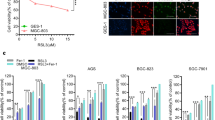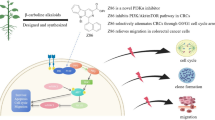Abstract
A number of small GTPases are involved in cancer cell proliferation, migration and invasion. They need to be prenylated for full biological functions. We have recently reported that 3-hydroxy-3-methylglutaryl-coenzyme A (HMG-CoA) reductase inhibitors, which block the biosynthesis of farnesylpyrophosphate and geranylgeranylpyrophosphate, inhibit in vitro invasion of human pancreatic cancer cells. In the present study, we examined the effects of two selective inhibitors of prenylation, a farnesyltransferase inhibitor (FTI-277) and a geranylgeranyltransferase type I inhibitor (GGTI-298), on in vitro invasion of cancer cells in a modified Boyden chamber assay. The invasion of COLO 320DM human colon cancer cells was inhibited potently by HMG-CoA reductase inhibitor lovastatin and GGTI-298 but weakly by FTI-277. The treatment of cancer cells with GGTI-298 markedly caused RhoA to decrease in the membrane fraction and accumulate in the cytosolic fraction, whereas it had almost no effect on the translocation of Ras. FTI-277 markedly inhibited membrane localization of Ras, but its inhibitory effect on cancer cell invasion occurred only at doses that affected membrane localization of RhoA. FTI-277 and GGTI-298 decreased the growth potential of COLO 320DM cells, but the inhibitory effect of GGTI-298 was rather selective toward invasion in association with changes in cell morphology and RhoA localization. These results suggest that geranylgeranylation of RhoA by geranylgeranyltransferase type I is critical for cancer cell invasion, and inhibition of geranylgeranyltransferase type I activity should offer a novel approach to the treatment of invasion and metastasis of cancer cells resistant to farnesyltransferase inhibitors.
Similar content being viewed by others
References
Hall A. Rho GTPases and the actin cytoskeleton. Science 1998; 279 (5350): 509–14.
Elson CE, Peffley DM, Hentosh P, Mo H. Isoprenoid-mediated inhibition of mevalonate synthesis: Potential application to cancer. Proc Soc Exp Biol Med 1999; 221 (4): 294–311.
Zhang FL, Casey PJ. Protein prenylation: Molecular mechanisms and functional consequences. Ann Rev Biochem 1996; 65: 241–69.
Kusama T, Mukai M, Iwasaki T et al. Inhibition of epidermal growth factor-induced RhoA translocation and invasion of human pancreatic cancer cells by 3-hydroxy-3-methylglutaryl-coenzyme A reductase inhibitors. Cancer Res 2001; 61 (12): 4885–91.
Kusama T, Mukai M, Iwasaki T et al. 3-hydroxy-3-methylglutarylcoenzyme A reductase inhibitors reduce human pancreatic cancer cell invasion and metastasis. Gastroenterology 2002; 122 (2): 308–17.
Miquel K, Pradines A, Sun J et al. GGTI-298 induces G0-G1 block and apoptosis whereas FTI-277 causes G2-M enrichment in A549 cells. Cancer Res 1997; 57 (10): 1846–50.
Mazet JL, Padieu M, Osman H et al. Combination of the novel farnesyltransferase inhibitor RPR130401 and the geranylgeranyltransferase-1 inhibitor GGTI-298 disrupts MAP kinase activation and G(1)-S transition in Ki-Ras-overexpressing transformed adrenocortical cells. FEBS Lett 1999; 460 (2): 235–40.
Sun J, Qian Y, Hamilton AD, Sebti SM. Both farnesyltransferase and geranylgeranyltransferase I inhibitors are required for inhibition of oncogenic K-Ras prenylation but each alone is sufficient to suppress human tumor growth in nude mouse xenografts. Oncogene 1998; 16 (11): 1467–73.
Lobell RB, Omer CA, Abrams MT et al. Evaluation of farnesyl: Protein transferase and geranylgeranyl: Protein transferase inhibitor combinations in preclinical models. Cancer Res 2001; 61 (24): 8758–68.
Kainuma O, Asano T, Hasegawa M et al. Inhibition of growth and invasive activity of human pancreatic cancer cells by a farnesyltransferase inhibitor, manumycin. Pancreas 1997; 15 (4): 379–83.
Nam J-S, Ino Y, Sakamoto M, Hirohashi S. Ras farnesylation inhibitor FTI-277 restores the E-cadherin/catenin cell adhesion system in human cancer cells and reduces cancer metastasis. Jpn J Cancer Res 2002; 93 (9): 1020–8.
Akedo H, Shinkai K, Mukai M et al. Interaction of rat ascites hepatoma cells with cultured mesothelial cell layers: A model for tumor invasion. Cancer Res 1986; 46 (5): 2416–22.
Imamura F, Shinkai K, Mukai M et al. Rho-mediated protein tyrosine phosphorylation in lysophosphatidic-acid-induced tumor-cell invasion. Int J Cancer 1996; 65 (5): 627–32.
Yoshioka K, Matsumura F, Akedo H, Itoh K. Small GTP-binding protein Rho stimulates the actomyosin system, leading to invasion of tumor cells. J Biol Chem 1998; 273 (9): 5146–54.
Yoshioka K, Nakamori S, Itoh K. Overexpression of small GTPbinding protein RhoA promotes invasion of tumor cells. Cancer Res. 1999; 59 (8): 2004–10.
Fritz G, Just I, Kaina B. Rho GTPases are over-expressed in human tumors. Int J Cancer 1999; 81 (5): 682–7.
Quinn LA, Moore GE, Morgan RT, Woods LK. Cell lines from human colon carcinoma with unusual cell products, double minutes, and homogeneously staining regions. Cancer Res 1979; 39 (12): 4914–24.
Pronk GJ, Bos JL. The role of p21ras in receptor tyrosine kinase signaling. Biochim Biophys Acta 1994; 1198 (2-3): 131–47.
Kohl NE, Mosser SD, deSolms SJ et al. Selective inhibition of rasdependent transformation by a farnesyltransferase inhibitor. Science 1993; 260 (5116): 1934–7.
Whyte DB, Kirschmeier P, Hockenberry TN et al. K-and N-Ras are geranylgeranylated in cells treated with farnesyl protein transferase inhibitors. J Biol Chem 1997; 272 (22): 14459–64.
Rowell CA, Kowalczyk JJ, Lewis MD, Garcia AM. Direct demonstration of geranylgeranylation and farnesylation of Ki-Ras in vivo. J Biol Chem 1997; 272 (22): 14093–7.
Di Paolo A, Danesi R, Nardini D et al. Manumycin inhibits ras signal transduction pathway and induces apoptosis in COLO320-DM human colon tumour cells. Br J Cancer 2000; 82 (4): 905–12.
Sebti SM, Hamilton AD. Farnesyltransferase and geranylgeranyltransferase I inhibitors and cancer therapy: Lessons from mechanism and bench-to-bedside translational studies. Oncogene 2000; 19 (56): 6584–93.
Author information
Authors and Affiliations
Corresponding author
Rights and permissions
About this article
Cite this article
Kusama, T., Mukai, M., Tatsuta, M. et al. Selective inhibition of cancer cell invasion by a geranylgeranyltransferase-I inhibitor. Clin Exp Metastasis 20, 561–567 (2003). https://doi.org/10.1023/A:1025898316728
Issue Date:
DOI: https://doi.org/10.1023/A:1025898316728




